Figures & data
Table I. Clinical and obstetrical characteristics of the study population.
Figure 1. Maternal plasma concentration of PlGF between women with an uncomplicated pregnancy and women with late-onset PE with and without underperfused placental lesions. Women with late-onset PE without underperfused placental lesions had a lower median plasma PlGF concentration than women with uncomplicated pregnancies. Similarly, women with late-onset PE with underperfused placental lesions had a lower median plasma PlGF concentration than women with uncomplicated pregnancies. Among women with late-onset PE, those who had underperfused placental lesions had a lower median plasma PlGF concentration than those without these lesions.
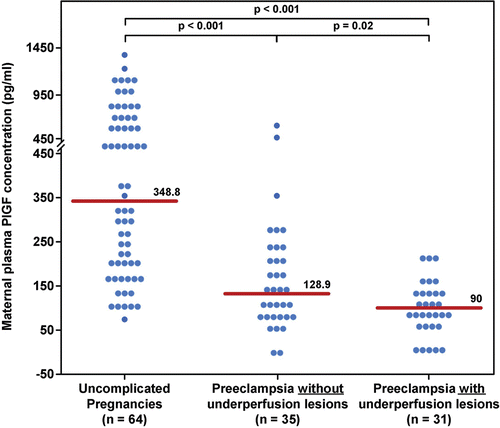
Figure 2. Maternal plasma PlGF/sVEGFR-1 ratio between women with an uncomplicated pregnancy and women with late-onset PE with and without underperfused placental lesions. Women with late-onset PE without underperfused placental lesions had a lower median plasma PlGF/sVEGFR-1 ratio than women with uncomplicated pregnancies. Similarly, women with late-onset PE with underperfused placental lesions had a lower median plasma PlGF/sVEGFR-1 ratio than women with uncomplicated pregnancies. Among women with late-onset PE, those with underperfused placental lesions had a lower median plasma PlGF/sVEGFR-1 ratio than women with late- onset PE without evidence of underperfused placental lesions.
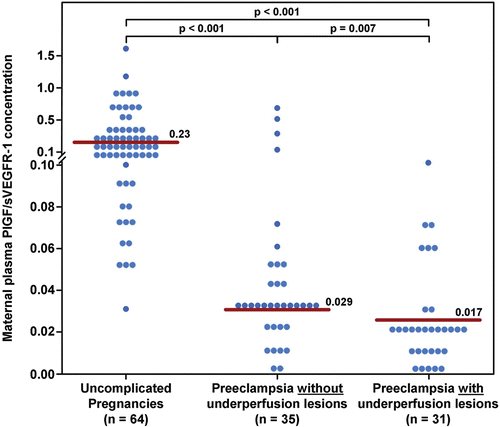
Figure 3. Maternal plasma PlGF/sEng ratio between women with an uncomplicated pregnancy and women with late-onset PE with and without underperfused placental lesions. Women with late-onset PE without underperfused placental lesions had a lower median plasma PlGF/sEng ratio than women with uncomplicated pregnancies. Similarly, women with late-onset PE with underperfused placental lesions had a lower median plasma PlGF/sEng ratio than women with uncomplicated pregnancies. Among women with late-onset PE, those with underperfused placental lesions had a lower median plasma PlGF/sEng ratio than women with late-onset PE without evidence of underperfused placental lesions.
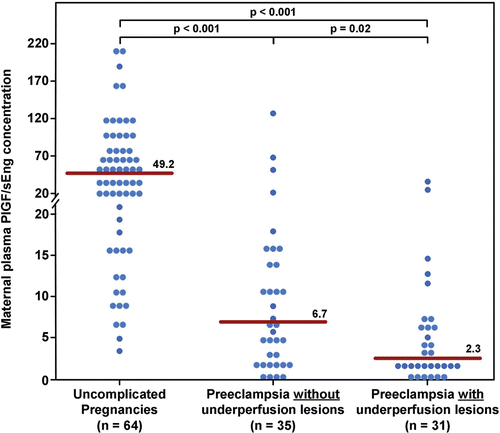
Figure 4. Maternal median plasma concentration of sEng between women with an uncomplicated pregnancy and women with late-onset PE with and without underperfused placental lesions. Women with late-onset PE without underperfused placental lesions had a higher median plasma sEng than women with uncomplicated pregnancies. Similarly, women with late-onset PE with underperfused placental lesions had a higher median plasma sEng than women with uncomplicated pregnancies. In contrast, there was no difference in the median plasma sEng between women with late-onset PE with or without underperfused placental lesions.
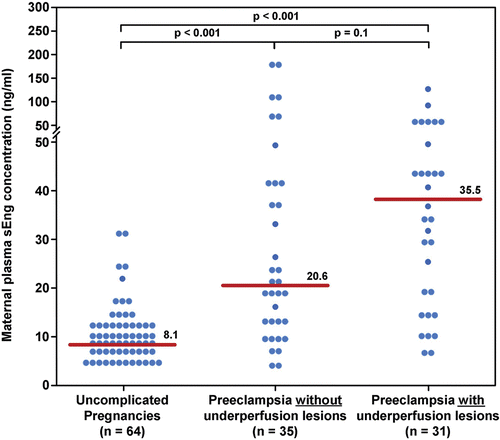
Figure 5. Maternal median plasma concentration of sVEGFR-1 between women with an uncomplicated pregnancy and women with late-onset PE with and without underperfused placental lesions. Women with late-onset PE without underperfused placental lesions had a higher median plasma sVEGFR-1 than women with uncomplicated pregnancies. Similarly, women with late-onset PE with underperfused placental lesions had a higher median plasma sVEGFR-1 than women with uncomplicated pregnancies. In contrast, there was no difference in the median plasma sVEGFR-1 between women with late-onset PE with or without underperfused placental lesions.
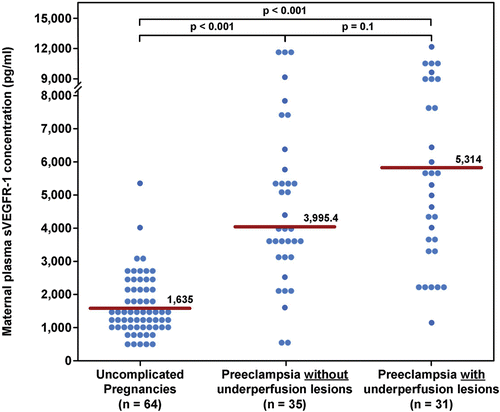
Figure 6. Maternal median plasma concentration of sVEGFR-2 between women with an uncomplicated pregnancy and women with late-onset PE with and without underperfused placental lesions. Women with late-onset PE without underperfused placental lesion had higher median plasma sVEGFR-2 than women with uncomplicated pregnancies. In contrast, there was no difference in the median plasma concentration of sVEGFR-2 between women with late-onset PE with underperfused placental lesions women with uncomplicated pregnancies. There was no difference in the median plasma sVEGFR-2 between women with late-onset PE with or without underperfused placental lesion.

Table II. Maternal plasma concentration of angiongenic and anti-angiogenic factors in the study population.